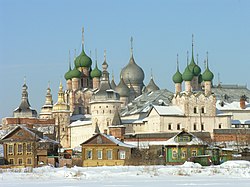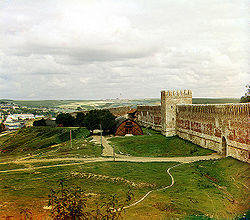Kremlin (fortification)
This article is missing information about history and common features. (August 2017) |
A kremlin (/ˈkrɛmlɪn/ KREM-lin ; Russian: кремль, romanized: kremlj, IPA: [ˈkrʲemlʲ] ) is a major fortified central complex found in historic Russian cities.[1][2] The word is often used to refer to the Moscow Kremlin[3] and metonymically to the government based there.[4] Other such fortresses are called detinets, such as the Novgorod Detinets.
Etymology
[edit]The Russian word is of uncertain origin. Different versions include the word originating from the Turkic languages, the Greek language or from Baltic languages.[5][6][7][8][9][10] The word may share the same root as kremen (Russian: кремень, romanized: kremenj, IPA: [krʲɪˈmʲenʲ] ), meaning 'flint'.[11]
History
[edit]This section needs additional citations for verification. (July 2021) |
Kremlins in Rus'
[edit]The Slavs began to build fortresses to protect their lands from enemies in the ninth century. It is known that the Scandinavians called the Slavic lands the land of fortresses—"Gardariki". Arabic geographer Al-Bakri wrote: "And that is how the Slavs build a large part of their fortresses: they head for meadows, rich in water and reeds, and there mark a round or rectangular place, depending on the shape they want to make a fortress, and they dig around the moat, and the dugout earth is dumped in a rampart, reinforcing it with planks and piles, like beaten earth, until the wall reaches the desired height. Then they measure the door at whichever side they want, and approach by a wooden bridge".[12] In ancient times, a wooden fence was built on the crest of a rampart, a palisade or zapolot (the wall made of logs, vertically one above the other, and connected with horizontally laid timbers). The way of defending the settlement was primitive; later wooden fortress walls became more preferable.
In the 8th century, the earliest known stone and wooden fortress—Lubšanská fortress near Staraya Ladoga was built. The ancient stone and wooden kremlins include a fortress on Truvorov settlement near Izborsk (9th century) and the first Stara Ladoga Kremlin (the end of the 9th century, later rebuilt). Single stone towers, gates and bends of walls appeared in other cities (Vladimir, Kyiv, Novgorod, Pereyaslavl): the Golden Gate of Kievan citadel and the gate of the Vladimir Kremlin bearing the same name survived.[13]
A special type of wooden and stone Kremlins appeared under the influence of architectural traditions of Poland and Hungary. They were characterised by the juxtaposition of wooden walls and towers with vezha—high stone towers standing inside the fortress, which were used as watchtowers. Constructions, called Volyn towers, were erected, for example, in the citadels of Kholmsk, Kamenets and Gorodeni.[13]
During the Mongol-Tatar invasion, many Russian wooden and stone-wooden fortresses were taken and destroyed by the Mongols. The long-lasting Mongol-Tatar yoke slowed down the development of Russian fortification architecture for a century and a half, as internecine wars stopped and the need to build fortresses disappeared.
The tradition of fortress construction was preserved in Novgorod and Pskov lands which were not damaged by the Mongol invasion. Here are built not only kremlins (Izborsk, Porkhov) but—for the first time in Russia—fortresses, which were not many cities in the full sense of the word, as defensive structures (Koporie, Oreshek, Yam, Korela, Ostrov, Kobyla). The strongest of the Russian fortresses was the Pskov Kremlin, which had no equal in Russia in the number of sustained sieges.[13]
Kremlins of the Russian state
[edit]The term Kremlin (in the variant Kremnik) is first encountered in chronicles of 1317 in accounts of the construction of the Tver Kremlin, where a wooden city-fortress was erected, which was clayed and whitewashed.[14]
Wooden fortresses were erected everywhere in the Russian state—from the Far East lands to the Swedish borders. They were numerous in the South, where they served as a link of fortified fortification zones cutting off the way to the central regions from Crimean Tatars. Aesthetically wooden fortresses were not inferior to stone ones—and we can regret that the towers of wooden kremlins have not survived to this day. Wooden fortresses were built quickly: in 1638 in Mtsensk fortress walls of Bolshoi Ostrog and Pletny Gorod with a total length of about 3 kilometres with 13 towers and almost one hundred meters long bridge over the River Zusha were erected in 20 days. The town of Sviyazhsk was built similarly during the Kazan campaign in the spring of 1551: fortress walls about 2.5 kilometres long, many churches and houses were erected in a month.
Later on, many Kremlins were rebuilt and strengthened. Thus, the Moscow Kremlin under Ivan the Third was reconstructed of bricks.
In the 16th and 17th centuries, about 30 stone fortresses were built in the Russian State. New Kremlins have regular geometric forms in plan (Zaraisky and Tula Kremlins). The Tula Kremlin is unique because it was built in a valley (which was possible because of undeveloped siege artillery of nomad Tatars).
Construction of the Kremlin lasted until the turn of the 17th and 18th centuries. The last Kremlin structure was built of stone between 1699 and 1717 in the town of Tobolsk (the easternmost Kremlin in Russia).
In Russia
[edit]World Heritage Sites
[edit]
- Moscow Kremlin (better known simply as the Kremlin)
- Novgorod Detinets
- Solovetsky Monastery
- Suzdal Kremlin
- Kazan Kremlin
Intact
[edit]- Astrakhan Kremlin
- Kolomna Kremlin
- Nizhny Novgorod Kremlin

Nizhny Novgorod Kremlin - Pskov Kremlin
- Rostov Kremlin (a bishop's residence, not formally considered a kremlin)

- Smolensk Kremlin

A wall of Smolensk Kremlin in 1912 
Remains of the Kolomna Kremlin - Tobolsk Kremlin (the sole stone kremlin in Siberia)
- Tula Kremlin
- Zaraysk Kremlin
- Ivangorod Fortress (not formally considered a kremlin)
- Oreshek Fortress (not formally considered a kremlin)
- Staraya Ladoga
- Alexandrov Kremlin (a czar residence, not formally considered a kremlin)
- Korela Fortress (not formally considered a kremlin)
- Izborsk Kremlin
In ruins
[edit]- Gdov Kremlin
- Porkhov Kremlin
- Serpukhov Kremlin
- Velikie Luki Kremlin
- Torzhok Kremlin
- Mozhaysk Kremlin
- Fortress of Koporye (not formally considered a kremlin)
- Vyazma Kremlin (one tower)
- Syzran Kremlin (one tower, 1683)
- Ufa
Existing and unwalled
[edit]- Vladimir Kremlin (Tower Golden Gate and bank)
- Dmitrov
- Ryazan
- Vologda (a bishop residence, not formally considered a kremlin)
- Yaroslavl (two towers)
- Pereslavl-Zalessky
- Khlynov (Vyatka)
- Volokolamsk
Traces remain
[edit]- Borovsk
- Opochka
- Zvenigorod
- Starodub
- Tver – a wooden fortress was burned down in a fire in 1763
- Sknyatino – underwater since flooding during the 1930s.
- Yam fortress (not formally considered a kremlin)
- Fortress of Radonezh
- Ryazan
- Old Ryazan [ru] (60 km from modern Ryazan)
- Ostrov (14th-15th centuries)
- Belgorod (bank of fortress)
- Vereya
- Kaluga
- Kleshchin
- Kostroma
- Pustozyorsk
- Uglich
- Staritsa
- Sviyazhsk
- Cheboksary
- Yuryev-Polsky
- Aleksin
- Opochka
- Oryol
- Rurikovo Gorodische
- Mtsensk
- Raskiel
Modern imitations
[edit]Outside Russia
[edit]After the disintegrations of the Kievan Rus, the Russian Empire and the USSR, some fortresses considered Kremlin-type, remained beyond the borders of modern Russia. Some are listed below:
- Belz, Ukraine (only traces)
- Kyiv, Ukraine (reconstructed tower of the Golden Gate)
- Putyvl, Ukraine
- Novhorod-Siverskyi, Ukraine
- Chernihiv, Ukraine (only traces)
- Kamyanyets, Belarus (shafts and Belaya Vezha tower)
- Belgorod Kievsky, Ukraine (now village Belgorodka)
The same structure in Novgorodshina, Ukraine and other Old Russian territories is also called dytynets (Ukrainian: дитинець, from dytyna – child). The term has been in use since the 11th century. The term kremlin first appeared in 14th century in various Russian territories, where it replaced dytynets.
Many Russian monasteries have been built in a fortress-like style similar to that of a kremlin. For a partial list, see Monasteries in Russia.
See also
[edit]References
[edit]This article includes a list of general references, but it lacks sufficient corresponding inline citations. (August 2017) |
- ^ Pleshakov, Constantine (2006). Stalin's Folly: The Tragic First Ten Days of World War II on the Eastern Front. Houghton Mifflin Harcourt. p. 24. ISBN 0618773614. Archived from the original on 2023-12-16. Retrieved 2020-11-06.
- ^ G, Frank, Ben (2010-09-23). A Travel Guide to Jewish Russia & Ukraine. Pelican Publishing. p. 150. ISBN 9781455613281. Archived from the original on 2023-12-16. Retrieved 2020-11-06.
{{cite book}}: CS1 maint: multiple names: authors list (link) - ^ Shubin, Daniel H. (2004). A History of Russian Christianity, Vol. I: From the Earliest Years through Tsar Ivan IV. Algora Publishing. p. 5. ISBN 9780875862873. Archived from the original on 2023-12-16. Retrieved 2020-11-06.
- ^ Barcelona, Antonio; Benczes, Réka; Ibáñez, Francisco José Ruiz de Mendoza (2011). Defining Metonymy in Cognitive Linguistics: Towards a Consensus View. John Benjamins Publishing. p. 234. ISBN 978-9027223821. Archived from the original on 2022-11-22. Retrieved 2020-11-06.
- ^ Toporov V.N. "Baltica" of the Moscow region // Balto-Slavic collection: collection of articles. - M .: Nauka, 1972. - pp . 276–277 .
- ^ Кремль, городская цитадель // Энциклопедический словарь Брокгауза и Ефрона : в 86 т. (82 т. и 4 доп.). — СПб., 1890—1907
- ^ "Кром — Кремник — Кремль - Архитектура - РУССКОЕ ВОСКРЕСЕНИЕ". www.voskres.ru. Archived from the original on 2017-02-28. Retrieved 2018-09-25.
- ^ "kremlin | Origin and meaning of kremlin by Online Etymology Dictionary". www.etymonline.com. Archived from the original on 2018-09-26. Retrieved 2018-09-26.
- ^ "The Russian Kremlins". Free Tour Saint Petersburg. 2016-01-13. Archived from the original on 2018-09-26. Retrieved 2018-09-26.
- ^ Thompson, Della, ed. (2009). Oxford essential Russian dictionary : Russian-English, English-Russian. Oxford: Oxford University Press. p. 89. ISBN 9780199576432. OCLC 502676920.
- ^ Russian Etymological Dictionary by Archived 2017-10-27 at the Wayback Machine Max Vasmer
- ^ "ЭСБЕ/Кремль, городская цитадель — Викитека". ru.wikisource.org (in Russian). Archived from the original on 2021-07-20. Retrieved 2021-07-20.
- ^ a b c Kradin Nikolai (1998). Russian wooden defensive architecture. Moscow: Art.
- ^ Yusupov E. (1994). Dictionary of Architectural Terms. Leningrad Gallery Foundation. p. 184.
Further reading
[edit]- Воронин Н. Н. Владимир, Боголюбово, Суздаль, Юрьев-Польской. М.: Искусство, 1967.
- Кирьянов И. А. Старинные крепости Нижегородского Поволжья. Горький: Горьк. книжн. изд., 1961.
- Косточкин В. В. Русское оборонное зодчество конца XIII — начала XVI веков. М.: Издательство Академии наук, 1962.
- Крадин Н. П. Русское деревянное оборонное зодчество". М.: Искусство, 1988.
- Раппопорт П. А. Древние русские крепости. М.: Наука, 1965.
- Раппопорт П. А. Зодчество Древней Руси. Л.: Наука, 1986.
- Раппопорт П. А. Строительное производство Древней Руси (X—XIII вв.). СПб: Наука, СПб, 1994.
- Сурмина И. О. Самые знаменитые крепости России. М.: Вече, 2002.
- Тихомиров М. Н. Древнерусские города. М.: Гос. изд. полит. лит-ры, 1956.
- Яковлев В. В. Эволюция долговременной фортификации. М.: Воениздат, 1931.
External links
[edit] Media related to Kreml at Wikimedia Commons
Media related to Kreml at Wikimedia Commons- Russian Fortification Architecture
- Twelve Russian Kremlins Archived 2011-01-19 at the Wayback Machine
- Cynthia Marsh. "Kremlin". Words of the World. Brady Haran (University of Nottingham).



